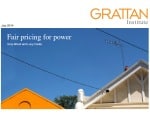The Grattan Institute’s Fair Pricing For Power report claims that if electricity charges were structured differently, network businesses may have saved nearly $8 billion in 5 years – savings that could have been passed on to customers.
The Institute says between 2008 to 2013, the average electricity bill in Australia jumped by 70 percent.
“Some of that burden is unfair, and is falling especially heavily on some power consumers, whose bills are subsidising others.”
It’s all in how much and when electricity is used.
The report states that the 43% portion of electricity bills that goes towards network costs (poles and wires), should be based on the load a households puts on the network during the time it is drawing the most power.
“Calculating bills based on a household’s maximum load far better reflects the real cost of running the network. If this cost can be reduced, so can consumer prices.”
“The reforms would raise prices for consumers who use more power in periods of peak demand, and reduce them for consumers who use less power in these times. In the short term the total consumer bill would stay the same, but in the long run, as unnecessary infrastructure is no longer built, prices across the board will fall.”
The reason of no relief in the short term is due to the gold-plating of electricity transmission networks in recent years; i.e. the infrastructure in place is generally surplus to demand and even more so in recent years thanks to the uptake of solar power.
As well as air-conditioners, the burden of which is massive, the Institute also points to an issue it says can occur with solar households.
“Some households will pay substantially less to use the network after they install rooftop solar, since more of the network charge is based on the amount of energy the household requires from the network. Yet, if consumption at peak times remains the same, then the cost a household imposes on the network will not change. Again, other users must pay more to cover the gap.”
This situation self-remedies in many cases as solar households tend to be more energy conscious; using heavy load appliances at off-peak times or when the weather conditions are favourable. Energy efficiency and cost cutting are two of the major reasons households go solar in the first place.
The full Fair Pricing For Power report can be downloaded here (PDF).












































